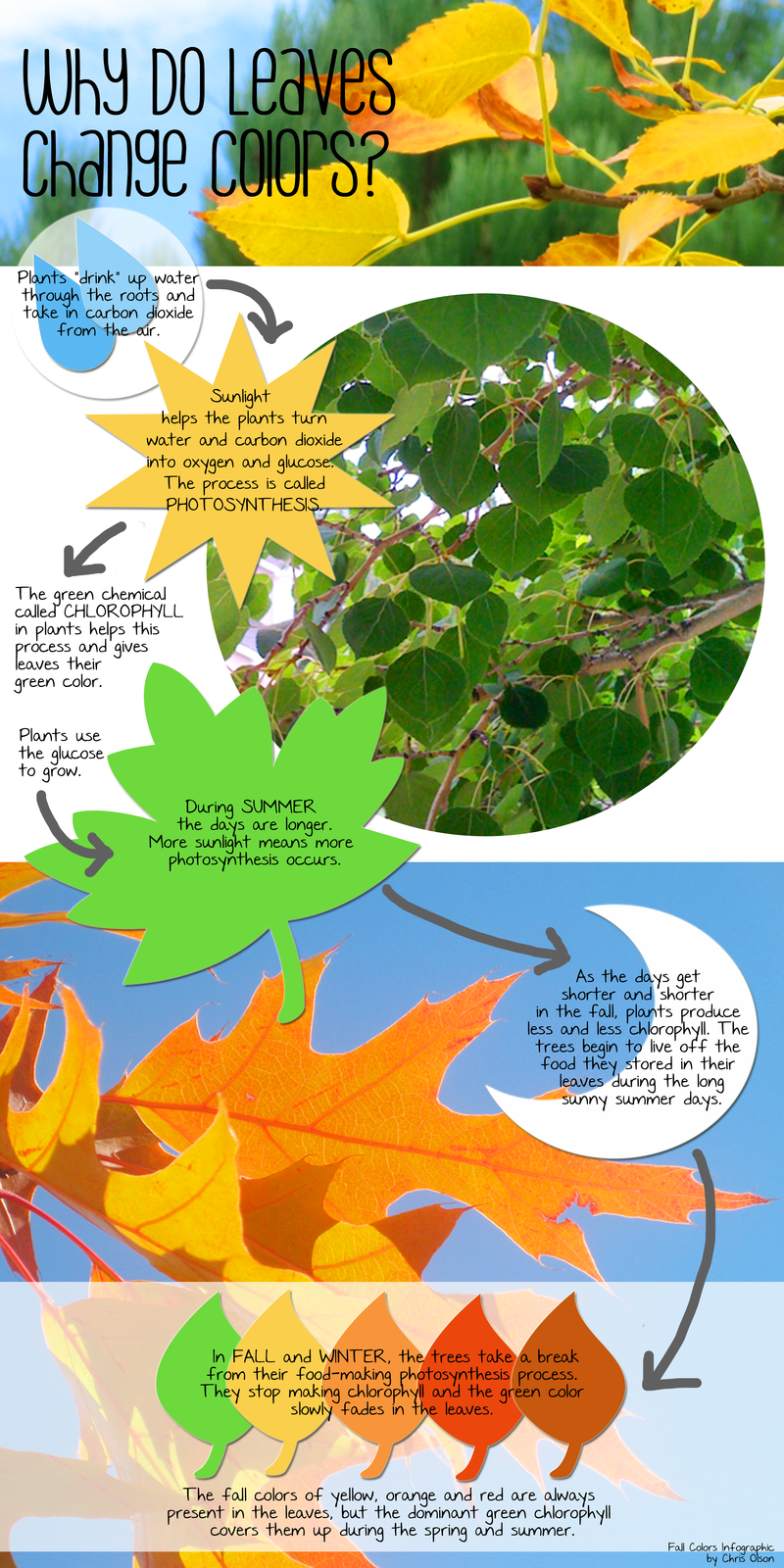why do leaves change color in the fall how does this affect photosynthesis
Through a process called photosynthesis chlorophyll transforms sunlight into energy that plants need to grow. During winter theres not enough water or light for photosynthesis to take place.
Why do leaves change color in the fall answers.

. The leaves serve as little manufacturers of food for the trees growth. In short the answer is that leaves are green because they store a chemical called chlorophyll. As the Sun becomes less intense in fall chlorophyll production slows down.
Plants need water carbon dioxide and sunlight to produce their food called glucose. Inside a leaf there are many pigments but. Some trees like oaks and dogwoods are likely to produce red leaves.
Sunlight is absorbed by a chemical in the trees leaves known as chlorophyll. In the winter there is not a lot of sunlight so deciduous trees and plants that lose their leaves in the fall trees begin to stop making food. This chemical is an important substance that allows the plant to capture sunlight and use it.
How much and how fast leaves transform varies by location on the globe. This is why leaves change color in the fall. Chlorophyll is the pigment that makes the leaves green.
To hold in watermoisture and to keep out bad things. In order for photosynthesis to happen the plant needs the help of chlorophyll. Chlorophyll is what gives a leaf its green color.
This food-making process takes place within the leaves cells which contain chlorophyll. Sugars that can get trapped in the leaves produce new pigments called anthocyanins that werent part of the leaf in the growing season. The leaves use a chemical called chlorophyll to capture sunshine.
Simply put leaves produce food for the tree. Chlorophyll gives a green color to the leaf. For some the reason why leaves are green may seem elementary but it is an important step in understanding why the leaves change color in the first place.
Darker red leaves are the result of a chemical change. Eventually a tree stops producing chlorophyll. During spring and summer trees make chlorophyll and food for the tree.
In fall however cooler and shorter days trigger an end to auxin production allowing the abscission layer to grow and cut off the circulation of water nutrients and sugar to the leaves. But the shortening days of autumn leads leaves to stop making chlorophyll meaning that the degraded chlorophyll isn. The yellow gold and orange colors created by carotenoid remain fairly constant from year to year.
Autumn Leaves - Goodbye Green Trees. Chlorophyll is created by the reaction of specialized leaf cells to sunlight and its what makes leaves look green. But to really understand the science behind this process we need to understand the purpose of leaves and how they do their work.
The chlorophyll breaks down with exposure to sunlight so the leaf must always make new chlorophyll. A severe drought can delay the arrival of fall colors by a few weeks. Chlorophyll absorbs red and blue light which is why it looks green.
The true colors of a leaf. Trees respond to the decreasing amount of sunlight by producing less and less chlorophyll. The trees have to live off the food they stored during the summer.
If the trees are stressed during the summer by dry conditions they may start losing their leaves or changing color early leading to less color in the fall. The amount of rain in a year also affects autumn leaf color. Photosynthesis continues leaves still look green and no-one suspects a thing.
Thats because carotenoids are always present in leaves and the amount does not change in response to weather. But falls cooler weather and shorter days signal to the tree that dormancy is coming and its time to close up shop for the winter. A Change Of Color In The Fall.
Chlorophyll by the way is what gives leaves their bright green color. One of the 4 main factors that lead to the chain reaction of leavescolor change in autumn. Plants obtain water from the air and.
Not only do leaves have substances of green pigment but yellow and orange pigments as well. Once the sunlight has been absorbed it reacts with the water and carbon dioxide that was also absorbed in order to produce sugars which is essentially plant food. Leaves change color due to changes in the length of daylight and temperature from summer to fall.
The main purpose of a tree sealing off the leaf from the stem.

Leaf Chromatography Science Experiment For Kids Science Experiments Kids Science Experiments Easy Science Experiments

8 Fun Science Activities For Kids About Leaves Science Activities For Kids Fun Science Science For Kids

Why Do Leaves Change Colors In Autumn Color Worksheets Leaf Lessons Color Lessons

Why Do The Leaves Change Color Fall Science Preschool Science Plant Science

Why Do Leaves Change Colors In Fall Preschool Science Kindergarten Science Homeschool Science

Why Do Leaves Change Color Worksheet Education Com Color Worksheets Third Grade Science Worksheets Biology Facts

Watch Leaves Change Color In A Matter Of Seconds Photosynthesis Plant Cell Structure Plant And Animal Cells

Photosynthesis Why Leaves Change Color Reading Supports Distance Learning Photosynthesis Photosynthesis Lessons Science Lesson Plans

Make A Science Fair Project Poster Ideas Why Do Leaves Change Colors Plant Scienc Science Projects For Kids Plants Science Project Science Fair Projects

Chicago Welcomes Fall Colors And Leaves Fall Colors Chicago Photos Fall

Photosynthesis Task Cards Supports Distance Learning Middle School Activities Photosynthesis Lessons Photosynthesis

Why Do Leaves Change Color And Fall In 2022 Biology Plants Horticulture Education Leaves Changing Color

Photosynthesis Why Leaves Change Color Reading Supports Distance Learning Photosynthesis Photosynthesis Lessons Science Lesson Plans

Science Experiments For Kids Why Do Leaves Change Color Fall Science Activities Fall Science Science Projects For Kids

Why Do Leaves Change Color And Fall Homeschool Science Plant Science Science Lessons

Beaker And Book On Twitter Fall Science Homeschool Science Preschool Science



